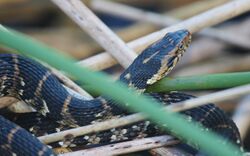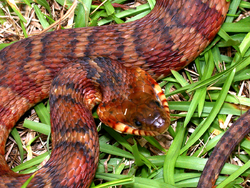Biology:Banded water snake
| Banded water snake | |
|---|---|

| |
| Scientific classification | |
| Domain: | Eukaryota |
| Kingdom: | Animalia |
| Phylum: | Chordata |
| Class: | Reptilia |
| Order: | Squamata |
| Suborder: | Serpentes |
| Family: | Colubridae |
| Genus: | Nerodia |
| Species: | N. fasciata
|
| Binomial name | |
| Nerodia fasciata (Linnaeus, 1766)
| |
| Synonyms[4] | |
| |
The banded water snake or southern water snake (Nerodia fasciata) is a species of mostly aquatic, nonvenomous, colubrid snakes most commonly found in the Midwest, Southeastern United States and Caribbean.
Geographic range
N. fasciata is natively found from Illinois, south to Louisiana, and east to Florida. This species has also been found in the Caribbean including St. Vincent.
In 1992, its congener Nerodia sipedon (northern or common water snake) and it were found in three sites in California by the US Fish and Wildlife Service (USFWS). In 2009, more than 300 banded water snakes were caught in suburbs of Los Angeles by the Nerodia Working Group of USFWS. Then in May 2016, the species was found in the Colorado River basin near Yuma, Arizona. Further trapping did indeed catch large numbers of them, indicating that a thriving invasive population exists in that area.[6][7][8]
Description
Adults of the banded water snake typically range from 61.0 to 107 cm (24.0 to 42.1 in) in total length, with a record size (in the Florida subspecies) of 158.8 cm (62.5 in) in total length.[9] In one study, the average body mass of adult banded water snakes was 464.3 g (16.38 oz).[10]
It is typically gray, greenish-gray, or brown in color, with dark crossbanding. Many specimens are so dark in color that their patterning is barely discernible. The ventrum (belly) is typically an off-white to white. They have flat heads, and are fairly heavy-bodied. Banded water snakes may also be identified by a dark stripe which extends from the eye to the angle of the jaw. If irritated, they release a foul-smelling musk to deter predators.[citation needed] This species also exhibits sexual dimorphism in which the female is generally longer and heavier than the male.[11] The average frequency of skin shedding has been found to be every four weeks.[12]
Their appearance leads them to be frequently mistaken for other snakes with which they share a habitat, including the venomous cottonmouth.
Habitat
N. fasciata inhabits most freshwater environments such as lakes, marshes, ponds, and streams.[13] Banded water snakes are active both day and night and may be seen basking on logs or branches overhanging the water or foraging in shallow water.[14] They will typically stay within emergent vegetation along the shoreline or in the shallow littoral zone of their habitat. [15]
Diet
The species preys mainly on fish and frogs.[16] On occasion, they prey on small turtles, small snakes, birds, earthworms, and crawfish.[17] Juveniles mainly consume fish and shift towards eating frogs as adults. This shift may be caused by large frogs being mechanically too difficult for juveniles to consume (which may suggest juveniles may be unable to open their jaws wide enough for adult frogs), because large frogs are energetically too costly for juveniles to catch, or because juveniles are at risk if swallowing prey requires a long time.[18]
Using its vomeronasal organ, also called Jacobson's organ, the snake can detect parvalbumins in the cutaneous mucus of its prey.[5]
Reproduction
The species is viviparous, giving birth to live young.[19] The brood size varies from 15 to 20 young born in late July or August.[14] Newborns are 200–240 mm (about 8.0–9.5 in) in total length.[20] The banded water snake is able to hybridize with the common watersnake, although this is not frequent. Physical characteristics are insufficient to distinguish such hybrids, and DNA analysis is required. [21]
Predator avoidance
When threatened, banded water snakes flatten their bodies to appear larger and emit a foul musk from their anal glands, and bite repeatedly. They will slash sideways when biting to tear the flesh of the attacker. [22]
Subspecies
The three recognized subspecies of N. fasciata, including the nominotypical subspecies, are:[19]
- N. f. confluens (Blanchard, 1923) - Broad-banded water snake [23] - Oklahoma, Arkansas, Louisiana, Mississippi, Missouri, East Texas.
- N. f. fasciata (Linnaeus, 1766) - East Texas, Louisiana, southeastern Oklahoma, Arkansas, western Mississippi, southern Alabama, Florida, southern Georgia, South Carolina, North Carolina, southeast Missouri and Illinois.
- N. f. pictiventris (Cope, 1895) – Florida banded water snake - Florida, southeast Georgia. Introduced to Brownsville, Texas and California .
Taxonomy
Some sources consider N. clarkii compressicauda and N. clarkii taeniata to be subspecies of N. fasciata.[24] Also, some sources have considered Nerodia fasciata to be a subspecies of Nerodia sipedon.[3][20][25]
References
- ↑ Hammerson, G.A. (2007). "Nerodia fasciata". IUCN Red List of Threatened Species 2007: e.T62237A12583389. doi:10.2305/IUCN.UK.2007.RLTS.T62237A12583389.en. https://www.iucnredlist.org/species/62237/12583389. Retrieved 19 November 2021.
- ↑ Boulenger, G.A. 1893. Catalogue of the Snakes in the British Museum (Natural History). Volume I., Containing the Families...Colubridæ Aglyphæ, part. Trustees of the British Museum (Natural History). (Taylor and Francis, Printers). London. xiii + 448 pp. + Plates I.- XXVIII. (Tropidonotus fasciatus, pp. 242–244.)
- ↑ 3.0 3.1 Stejneger, L., and T. Barbour. 1917. A Check List of North American Amphibians and Reptiles. Harvard University Press. Cambridge, Massachusetts. 125 pp. (Natrix sipedon fasciata, p. 96.)
- ↑ "Nerodia fasciata". Species. GBIF. http://www.gbif.org/species/5223349.
- ↑ 5.0 5.1 Smargiassi, M. T.; Daghfous, G.; Leroy, B.; Legreneur, P.; Toubeau, G.; Bels, V.; Wattiez, R. (2012). Permyakov, Eugene A. ed. "Chemical Basis of Prey Recognition in Thamnophiine Snakes: The Unexpected New Roles of Parvalbumins". PLOS ONE 7 (6): e39560. doi:10.1371/journal.pone.0039560. PMID 22761824. Bibcode: 2012PLoSO...739560S.
- ↑ "Battling an invasion of watersnakes – US Fish & Wildlife Service – Pacific Southwest Region". http://www.fws.gov/cno/newsroom/featured/2016/Invasive_Nerodia/.
- ↑ "California Nerodia Watch". https://www.inaturalist.org/projects/california-nerodia-watch.
- ↑ "Florida Watersnake - Nerodia fasciata pictiventris". http://www.californiaherps.com/snakes/pages/n.fasciata.html.
- ↑ [1]
- ↑ [2][yes|permanent dead link|dead link}}]
- ↑ Semlitsch, Raymond D.; Gibbons, J. Whitfield (1982-12-21). "Body Size Dimorphism and Sexual Selection in Two Species of Water Snakes". Copeia 1982 (4): 974. doi:10.2307/1444113. ISSN 0045-8511. http://dx.doi.org/10.2307/1444113.
- ↑ Brown, E. E. (1956). "Frequency of Skin Shedding in the Northern Banded Water Snake". Herpetologica 12 (4): 313–320. ISSN 0018-0831. https://www.jstor.org/stable/3889849.
- ↑ Conant, R. 1975. A Field Guide to Reptiles and Amphibians of Eastern and Central North America, Second Edition. Houghton Mifflin. Boston. xviii + 429 pp. ISBN:0-395-19977-8 (paperback). (Natrix fasciata fasciata, p. 146 + Plate 20 + Map 100.)
- ↑ 14.0 14.1 "Species Profile: Banded Watersnake (Nerodia fasciata) | SREL Herpetology". https://srelherp.uga.edu/snakes/nerfas.htm.
- ↑ Camper, & Chick, L. D. (2010). Seasonal Variation in the Spatial Ecology of the Banded Watersnake (Nerodia fasciata fasciata). Herpetologica, 66(4), 464–475. https://doi.org/10.1655/09-029.1
- ↑ Conant, R., and W. Bridges. 1939. What Snake Is That? A Field Guide to the Snakes of the United States East of the Rocky Mountains. D. Appleton-Century. New York and London. Frontispiece map + viii + 163 pp. + Plates A-C, 1–32. (Natrix sipedon fasciata, p. 103 + Plate 18, Figure 53.)
- ↑ "Nerodia fasciata (Southern Water Snake)". https://animaldiversity.org/accounts/Nerodia_fasciata/.
- ↑ Vincent, S.E.; Shine, R.; Herrel, A. (2006). "The functional meaning of "prey size" in water snakes (Nerodia fasciata, Colubridae)". Oecologia 147 (2): 204–211. doi:10.1007/s00442-005-0258-2. PMID 16237539. Bibcode: 2006Oecol.147..204V. https://doi.org/10.1007/s00442-005-0258-2.
- ↑ 19.0 19.1 Species Nerodia fasciata at The Reptile Database
- ↑ 20.0 20.1 Wright, A.H., and A.A. Wright. 1957. Handbook of Snakes of the United States and Canada. Comstock. Ithaca and London. 1,105 pp. (in 2 volumes) (Natrix sipedon fasciata, pp. 525–529, Figure 156.)
- ↑ Mebert, Konrad (2003). Hybridization Between the Watersnakes Nerodia sipedon and Nerodia fasciata, in the Carolinas: A Morphological and Molecular Approach (PhD thesis). Old Dominion University. doi:10.25777/658k-4603.
- ↑ “Snakes.” Amphibians and Reptiles of North Carolina, https://herpsofnc.org/banded-watersnake/.
- ↑ Powell, R., Conant, R., Collins, J. T., Conant, I. H., Johnson, T. R., Hooper, E. D., Taggart, T. W., Conant, R., & Collins, J. T. (2016). Peterson Field Guide to Reptiles and amphibians of Eastern and central North America. Houghton Mifflin Harcourt.
- ↑ ITIS (Integrated Taxonomic Information System). www.itis.gov.
- ↑ Schmidt, K.P., and D.D. Davis. 1941. Field Book of Snakes of the United States and Canada. G.P. Putnam's Sons. New York. 365 pp. (Natrix sipedon fasciata, pp. 221–222, Figure 72. + Plate 24, Center, on p. 344.)
Other sources
External links
Further reading
- Linnaeus, C. 1766. Systema naturæ per regna tria naturæ, secundum classes, ordines, genera, species, cum characteribus, differentiis, synonymis, locis. Tomus I. Editio Duodecima, Reformata. L. Salvius. Stockholm. 532 pp. (Coluber fasciatus, p. 378.)
Wikidata ☰ Q2065834 entry
 |



